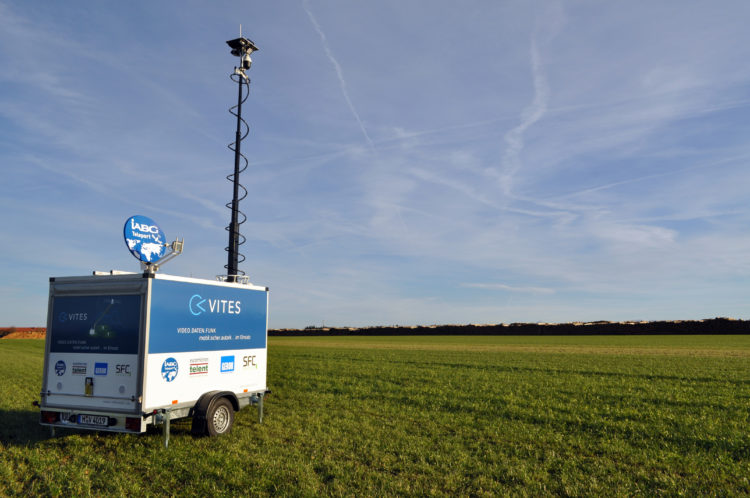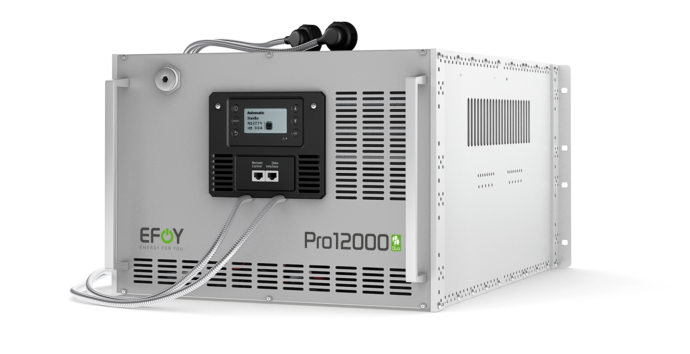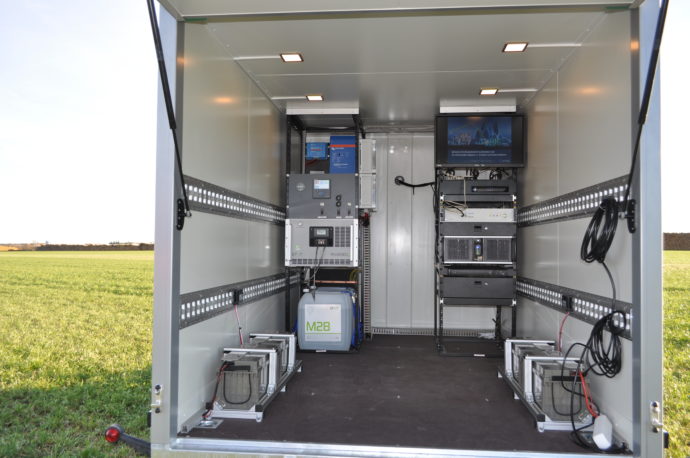
SFC Energy provide ready-to-go mobile and static power plants for all kinds of interesting applications incorporating EFOY fuel cells.
The Vikomobile, for example, is a communication hub mounted into a standard vehicle trailer. It has been designed to provide surveillance; data-transmission; mobile broadband; satellite communications; mobile telephone; and/or as part of secure/military communication nodes.
The Vikomobile can be connected to the grid – in which circumstance, of course, it is able to provide itself with an uninterrupted power supply in case of grid failure. But these units are principally designed to provide their Rx/Tx equipment either with a combination of solar power with fuel-cell generator back-up – or else they run on fuel-cells alone …with long maintenance intervals being possible where the power draw is relatively low, and more than one fuel cartridge is installed.
This is how a grid-connected installation with fuel-cell back-up might work:
A Multiplus charges the Lead/Acid batteries in normal circumstances. In the event of power failure, the Multiplus provides uninterrupted power to on-board services; and if the battery voltage falls below a pre-set level, the Multiplus automatically starts the generator – which in this case is the fuel-cell. Fuel-cells are power generators …but not in the noisy diesel sense: At a distance of 7 metres EFOY claim their smaller fuel-cells have a noise level of 25 decibels – that’s a bit louder than the sound of rustling leaves. The exhaust is not too troublesome either – it is mainly Carbon Dioxide and Water. And these fuel-cells can ‘run’ for a very long time: Twin cartridge models (2 x 28 ltr) are able to meet a 25W demand for 15 weeks. Or where their role is to sit in the background – waiting to automatically provide essential power on-demand, it’s handy to know that they have a shelf-life of several years. Another advantage to these fuel-cells is their small size which can be achieved because Methanol is a high energy-density fuel: SFC Energy say that with the maximum 4 x 60 litre cartridges fitted to single cell a total of 264kWh of power is available.

EFOY’s direct methanol fuel-cell. This model delivers up to 500W – in operation it’s as ‘noisy’ as a Library.
SFC Energy’s mobile and stationary installations have a supreme advantage over remote power units which rely on PV panels alone for their power generation. By having fuel-cell back-up their units continue to operate normally when there is one of those inevitable periods of extended bad weather and the PV panels just cannot cope with daily demand.
SFC Energy are particularly enthusiastic about how the Victron CCGX provides their units with a remote controlling ability – via VRM – and also the way Victron equipment ‘drops in’ to the system without any compatibility issues. They also appreciate the fact that there is a Victron-module sized for every requirement, available off-the-shelf, with short lead times. And as SFC Energy are a leading provider of fuel-cell technology – with over 39,000 units sold – it’s great to be part of their success story!















